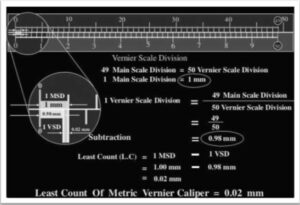Table of Contents
Vernier Caliper Least Count Formula: A Vernier Caliper is a measuring tool used to take accurate measurements of an object’s external or internal dimensions. It consists of two arms, one of which is fixed and the other of which is moveable. The arms are connected at one end by a vernier scale, which is used to take measurements. The vernier calliper is a very precise tool and is used in a variety of industries, including engineering and manufacturing.
The Vernier caliper was named after French scientist Pierre Vernier in 1631 who invented this instrument. The significance of this tool is that it can measure one-hundredth of a millimeter and one-thousandth of an inch precision. Vernier calipers are typically used to display imperial or metric measurements. Some of them, though, are measured in both. A vernier caliper is the best for evaluating the diameter of circular items like cylinders. In this article, we will learn everything about the vernier caliper and vernier caliper least count formula, and its significance.
Latest- JEE Main Session 2 Registration Closed | IIT JEE Main 2024 Toppers List | JEE Main City Intimation Slip 2024 Session 2
New – JEE Mains Registration 2024 Session 2 | JEE Mains Admit Card 2024 Session 2
Join Our Courses: JEE Class 11 Students | JEE Class 12 Students | JEE Dropper
What is Vernier Calliper?
Vernier Calipers are available in a variety of sizes. The smallest and smallest measurement gap determines a vernier caliper’s maximum capacity. It’s usually the entire length of the vernier caliper’s primary scale. The range of vernier calipers is usually 300 mm. However, lower-range vernier calipers are also available on the market.
Reading Vernier: A vernier reading is the smallest measurable distance that a vernier caliper can capture. A vernier caliper’s “Resolution” is another name for it. A metric vernier caliper’s resolution, or smallest measurable distance, varies from 0.02 mm to 0.05 mm, while an imperial caliper’s resolution is usually 0.001 inches. At the page’s bottom is a reference to the resolution.
Important concepts of Vernier Caliper & Least Count
The Vernier caliper least count formula is calculated by dividing the smallest main scale reading by the overall number of vernier scale segments. The difference between one least main scale reading and the smallest vernier scale reading of 0.1 mm or 0.01 cm is the L.C. of a vernier caliper.
The least count mistakes that is proportional to the resolution of the instrument. Using a meter scale shape computation of length can contain graduations at 1 mm division scale spacing or interval. A micrometer can have a minimum count of 0.001 mm, while a Vernier caliper scale could have a minimum of 0.01 mm.
The main scale reading is multiplied by the total number of divisions on the main scale to determine the Least Count measuring instrument. If the methodology has a Secondary Size, that’s even better. Then there’s instrument L.C., which is the major scale L.C. ratio. The set of sub-divisions is also important.
This value represents the difference between one main scale division and one vernier scale division. Understanding the vernier caliper least count in mm is essential for achieving accurate and precise measurements in various applications, making it a fundamental concept in the use of vernier calipers.
A vernier caliper is a device used to make precise linear measurements. It consists of two graded scales: the primary scale, which looks like a normal ruler, and the auxiliary scale, also known as the Vernier scale. The Vernier Calipers have two jaws, one permanent and the other movable, connected to the Vernier scale. We can take readings on the Vernier scale up to a fraction of a division on the main scale.
The least count, commonly known as the Vernier constant, is the smallest value measuring equipment can measure. In the case of a Vernier caliper, the Vernier scale has slightly smaller sections.
Least count = Smallest reading on main scale/ Number of divisions on Vernier scale = 1 mm/10
The difference between one main scale split and one Vernier scale division can also be used to compute the least count. Based on the position of zero on the Vernier scale and main scale, the information we acquire from the measurement of least count is normally an error that can be positive or negative.

The precision of a Vernier caliper’s readings is measured by intolerance or instrument error. Low tolerance measurement values are usually calculated with vernier calipers. Because the error probability is low, low tolerance measurement readings produce dependable and accurate findings. In general, Vernier calipers have a tolerance of around +/- 0.03mm (+- 0.0015 in).
- It is capable of determining the component’s outside diameter.
- It is capable of determining the inner diameter of a particular component.
- It is capable of determining the depth of a particular component.
- It is capable of determining the length of a given component.
What is Zero Error?
Zero error in a vernier calliper is defined as the condition when the measuring device registers a reading when there should not be any reading. There are two types of zero error: positive zero error and negative zero error. The zero error of a vernier calliper can be calculated as follows:
Actual reading = Main scale + Vernier scale – (Zero error)
To solve examples related to vernier callipers, you can follow these steps:
- Identify the main scale reading (MSR) and vernier scale reading (VSR) on the vernier calliper.
- Calculate the zero error using the vernier caliper least count formula provided above.
- Determine the actual reading by adding the main scale reading and vernier scale reading.
Example 1, the jaws of the vernier calliper are in contact with each other, and the least count (LC) is 0.1 mm. The main scale reading (MSR) is 0 mm, and the vernier scale reading (VSR) is 3. The zero error can be calculated as follows:
Zero error = MSR + VSR x LC = 0 + 3 x 0.1 = 0.3 mm
In Example 2, the main scale division (MSD) is 1 mm, and there are 20 vernier scale divisions (VSD). The least count (LC) can be calculated as:
LC = 1 MSD – 1 VSD = 1 – (9/10) = 0.1 mm
These examples demonstrate how to calculate the zero error and read the vernier calliper. Vernier callipers are used in various fields, including medical, scientific labs, steel, and aerospace industries, for measuring the dimensions of objects accurately.
The vernier caliper least count in mm is a crucial aspect of precision measurement tools. It refers to the smallest measurement increment that a vernier caliper can accurately read. Typically, the vernier caliper least count in mm is 0.02 mm or 0.01 mm, depending on the model.

JEE Foundation Class for 10
JEE Foundation Class for 10 enhances critical thinking and problem-solving skills through engaging activities and advanced learning techniques, ensuring academic excellence.
How to Read Vernier Calliper?
Here’s a straightforward guide on how to read a vernier caliper:
- Zero it Out: Close the jaws to align the 0s on both the main scale and vernier scale precisely. This makes sure your measurement starts from the right point.
- Main Scale Reading: Look at the main scale for the whole number and the first decimal of your measurement. Read it like you would a regular ruler, using the 0 mark on the vernier scale to figure out which line to read.
- Vernier Scale Reading: Locate the mark on the vernier scale that lines up with a mark on the main scale. Add the value of this mark on the vernier scale to the main scale reading to get your final measurement.
FAQs on Vernier Caliper Least Count
What is 0.02 least count?
The least count of an instrument is its smallest measurable value. For example, a vernier caliper with a least count of 0.02 mm can measure minimum values of 0.02 mm. Any value less than 0.02 mm cannot be measured using this vernier caliper.
Is 0.01 is the least count of vernier caliper?
The vernier caliper has a least count of 0.01 cm, and n divisions of the vernier scale correspond to 10 divisions of the main scale.
What is minimum vernier caliper?
A Vernier scale on caliper have a least count of 0.02 mm.
What's the distinction between a vernier and a caliper, and how do you use them?
A caliper is a device that measures the distance between two surfaces of an object, whereas a vernier is a secondary scale with finer graduations (for exact measurements) than a measuring equipment's primary scale. Between the graduations of the main scale, the vernier scale measures readings.
What does the term least count mean?
The smallest detectable length by the vernier caliper is referred to as the least count. It can be calculated by multiplying the difference between two vernier scale values by the number of divisions (usually 10).
What does negative zero error signify, and how can it be avoided?
A negative zero mistake occurs when the lower jaws come into contact. The zero mark on the vernier scale falls to the left of the main scale zero mark. To acquire an exact value, add the value on the vernier scale at this position to all subsequent readings.
What are the disadvantages of using a vernier caliper?
A bad angle of view can lead to incorrect readings being recorded. If you're not paying attention, you can end yourself recording the wrong reading.
What are the benefits of using a vernier caliper?
Vernier calipers have two key advantages: The vernier caliper provides accurate and exact measurements. It can measure both the interior and exterior dimensions of a surface.
What is the vernier caliper least count formula?
Least count = Smallest reading on main scale/ Number of divisions on Vernier scale = 1 mm/10.
Is 0.01 is the least count of vernier caliper?
Yes, 0.01 is the least count of vernier caliper.
Can vernier caliper measure 0.01 mm?
Yes, you can use a vernier caliper to measure a length accurately up to 0.01 cm.









